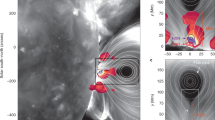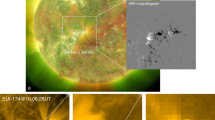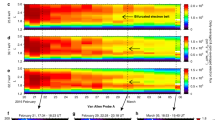Abstract
Radiofrequency emissions have been observed previously during vertical hypervelocity impacts into hard targets, but the dominant magnetic signatures of these events were attributed to amplification of the applied magnetic field1–3. Here we report laboratory experiments which document spontaneous magnetic fields generated by low-angle, hypervelocity impacts in a low-field environment. Low-angle impacts enhance the production of a partially ionized vapour cloud (a dusty plasma) which expands above the impact point4,5. The observed spontaneous magnetic fields may result from runaway thermal electrons producing a toroidal field confined to this plasma and by non-aligned thermal and electron density gradients producing a vertical field within the target6,7. These new observations hold promise both for experimentally probing early-time impact phenomena and for understanding the anomalously high thermal magnetic remanence observed in a young lunar impact melt returned by Apollo 17 (ref. 8). They also may provide clues for understanding the enigmatic record of broad-scale magnetic anomalies on the Moon9,10 and anticipated palaeomagnetic signatures from future missions such as the Soviet rendezvous with Phobos.
This is a preview of subscription content, access via your institution
Access options
Subscribe to this journal
Receive 51 print issues and online access
$199.00 per year
only $3.90 per issue
Buy this article
- Purchase on Springer Link
- Instant access to full article PDF
Prices may be subject to local taxes which are calculated during checkout
Similar content being viewed by others
References
Martelli, G. & Newton, G. Nature 269, 478–480 (1977).
Srnka, L. J. et al. Earth planet. Sci. Lett. 42, 127–137 (1979).
Bianchi, R. et al. Nature 308, 830–832 (1984).
Schultz, P. H. & Gault, D. E. Lunar planet. Sci. 16th, 740–741 (1985).
Schultz, P. H. Lunar planet. Sci. 19th, 1039–1040 (1988).
Hide, R. The Moon 4, 39 (1972).
Srnka, L. J. Proc. Lunar Sci. Conf. 8th, 785–792 (1977).
Sugiura, N. et al. Proc. Lunar planet. Sci. Conf. 10th, 2189–2197 (1979).
Hood, L. L., Coleman, P. J. & Wilhelms, D. E. Proc. Lunar planet. Sci. Conf. 10th, 2235–2257 (1979).
Schultz, P. H. & Srnka, L. J. Nature 284, 22–26 (1980).
Lin, S., Resler, E. L. & Kantrowitz, A. J. appl. Phys. 26, 95–110 (1955).
Hood, L. L. & Vickery, A., J. geophys. Res. Suppl. 89, C211–C223 (1984).
Arndt, J., Flad, K. & Feth, M. Proc. Lunar Sci. Conf. 10th, 355–373 (1979).
Dolginov, Sh. Sh. et al. in The Soviet-American Conference on Cosmochemistry of the Moon and Planets (eds Pomeroy, J. H. & Hubbard, N. J.) NASA SP-370 Part 1, 433–441 (1977).
Ivanov, B. A., Okulessky, B. A. & Basilevsky, A. T. in Impact and Explosion Cratering 861–867 (Pergamon, New York, 1977).
Author information
Authors and Affiliations
Rights and permissions
About this article
Cite this article
Crawford, D., Schultz, P. Laboratory observations of impact–generated magnetic fields. Nature 336, 50–52 (1988). https://doi.org/10.1038/336050a0
Received:
Accepted:
Issue Date:
DOI: https://doi.org/10.1038/336050a0
This article is cited by
-
Sub-microscopic magnetite and metallic iron particles formed by eutectic reaction in Chang’E-5 lunar soil
Nature Communications (2022)
-
Evidence of Cosmic Impact at Abu Hureyra, Syria at the Younger Dryas Onset (~12.8 ka): High-temperature melting at >2200 °C
Scientific Reports (2020)
-
Theoretical modeling and numerical simulations of plasmas generated by shock waves
Science China Technological Sciences (2019)
-
Paleomagnetic Records of Meteorites and Early Planetesimal Differentiation
Space Science Reviews (2010)
-
Palaeomagnetism of the Vredefort meteorite crater and implications for craters on Mars
Nature (2005)
Comments
By submitting a comment you agree to abide by our Terms and Community Guidelines. If you find something abusive or that does not comply with our terms or guidelines please flag it as inappropriate.



